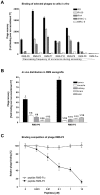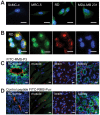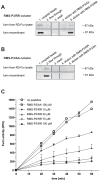Furin targeted drug delivery for treatment of rhabdomyosarcoma in a mouse model
- PMID: 20454619
- PMCID: PMC2862740
- DOI: 10.1371/journal.pone.0010445
Furin targeted drug delivery for treatment of rhabdomyosarcoma in a mouse model
Abstract
Rhabdomyosarcoma (RMS) is the most common soft tissue sarcoma in children. Improvement of treatment efficacy and decreased side effects through tumor-targeted drug delivery would be desirable. By panning with a phage-displayed cyclic random peptide library we selected a peptide with strong affinity for RMS in vitro and in vivo. The peptide minimal binding motif Arg-X-(Arg/Lys)(Arg/Lys) identified by alanine-scan, suggested the target receptor to be a proprotein convertase (PC). Expression profiling of all PCs in RMS biopsies and cell lines revealed consistent high expression levels for the membrane-bound furin and PC7. Direct binding of RMS-P3 peptide to furin was demonstrated by affinity chromatography and supported by activity and colocalization studies. Treatment of RMS in mice with doxorubicin coupled to the targeting peptide resulted in a two-fold increase in therapeutic efficacy compared to doxorubicin treatment alone. Our findings indicate surface-furin binding as novel mechanism for therapeutic cell penetration which needs to be further investigated. Furthermore, this work demonstrates that specific targeting of membrane-bound furin in tumors is possible for and suggests that RMS and other tumors might benefit from proprotein convertases targeted drug delivery.
Conflict of interest statement
Figures







Similar articles
-
The Proprotein Convertase Furin Contributes to Rhabdomyosarcoma Malignancy by Promoting Vascularization, Migration and Invasion.PLoS One. 2016 Aug 22;11(8):e0161396. doi: 10.1371/journal.pone.0161396. eCollection 2016. PLoS One. 2016. PMID: 27548722 Free PMC article.
-
The proprotein convertase furin is required to maintain viability of alveolar rhabdomyosarcoma cells.Oncotarget. 2016 Nov 22;7(47):76743-76755. doi: 10.18632/oncotarget.11648. Oncotarget. 2016. PMID: 27572312 Free PMC article.
-
Prolonged circulation and increased tumor accumulation of liposomal vincristine in a mouse model of rhabdomyosarcoma.Nanomedicine (Lond). 2017 May;12(10):1135-1151. doi: 10.2217/nnm-2017-0430. Epub 2017 Apr 27. Nanomedicine (Lond). 2017. PMID: 28447920
-
The proprotein convertases furin and PACE4 play a significant role in tumor progression.Mol Carcinog. 2000 Jun;28(2):63-9. Mol Carcinog. 2000. PMID: 10900462 Review.
-
Furin: a mammalian subtilisin/Kex2p-like endoprotease involved in processing of a wide variety of precursor proteins.Biochem J. 1997 Nov 1;327 ( Pt 3)(Pt 3):625-35. doi: 10.1042/bj3270625. Biochem J. 1997. PMID: 9599222 Free PMC article. Review.
Cited by
-
Quantum Dot-Based Screening Identifies F3 Peptide and Reveals Cell Surface Nucleolin as a Therapeutic Target for Rhabdomyosarcoma.Cancers (Basel). 2022 Oct 14;14(20):5048. doi: 10.3390/cancers14205048. Cancers (Basel). 2022. PMID: 36291832 Free PMC article.
-
On the cutting edge of proprotein convertase pharmacology: from molecular concepts to clinical applications.Biomol Concepts. 2011 Oct 1;2(5):421-438. doi: 10.1515/bmc.2011.034. Biomol Concepts. 2011. PMID: 22308173 Free PMC article.
-
Molecular ZIP codes in targeted drug delivery.Proc Natl Acad Sci U S A. 2022 Jul 12;119(28):e2200183119. doi: 10.1073/pnas.2200183119. Epub 2022 Jun 30. Proc Natl Acad Sci U S A. 2022. PMID: 35771944 Free PMC article. Review.
-
The Proprotein Convertase Furin Contributes to Rhabdomyosarcoma Malignancy by Promoting Vascularization, Migration and Invasion.PLoS One. 2016 Aug 22;11(8):e0161396. doi: 10.1371/journal.pone.0161396. eCollection 2016. PLoS One. 2016. PMID: 27548722 Free PMC article.
-
Computational prediction of furin cleavage sites by a hybrid method and understanding mechanism underlying diseases.Sci Rep. 2012;2:261. doi: 10.1038/srep00261. Epub 2012 Feb 16. Sci Rep. 2012. PMID: 22355773 Free PMC article.
References
-
- De Giovanni C, Landuzzi L, Nicoletti G, Lollini PL, Nanni P. Molecular and cellular biology of rhabdomyosarcoma. Future Oncol. 2009;5:1449–1475. - PubMed
-
- Breitfeld PP, Meyer WH. Rhabdomyosarcoma: new windows of opportunity. Oncologist. 2005;10:518–527. - PubMed
-
- Adams GP, Weiner LM. Monoclonal antibody therapy of cancer. Nat Biotechnol. 2005;23:1147–1157. - PubMed
-
- Cortez-Retamozo V, Backmann N, Senter PD, Wernery U, De Baetselier P, et al. Efficient cancer therapy with a nanobody-based conjugate. Cancer Res. 2004;64:2853–2857. - PubMed
Publication types
MeSH terms
Substances
LinkOut - more resources
Full Text Sources
Other Literature Sources

